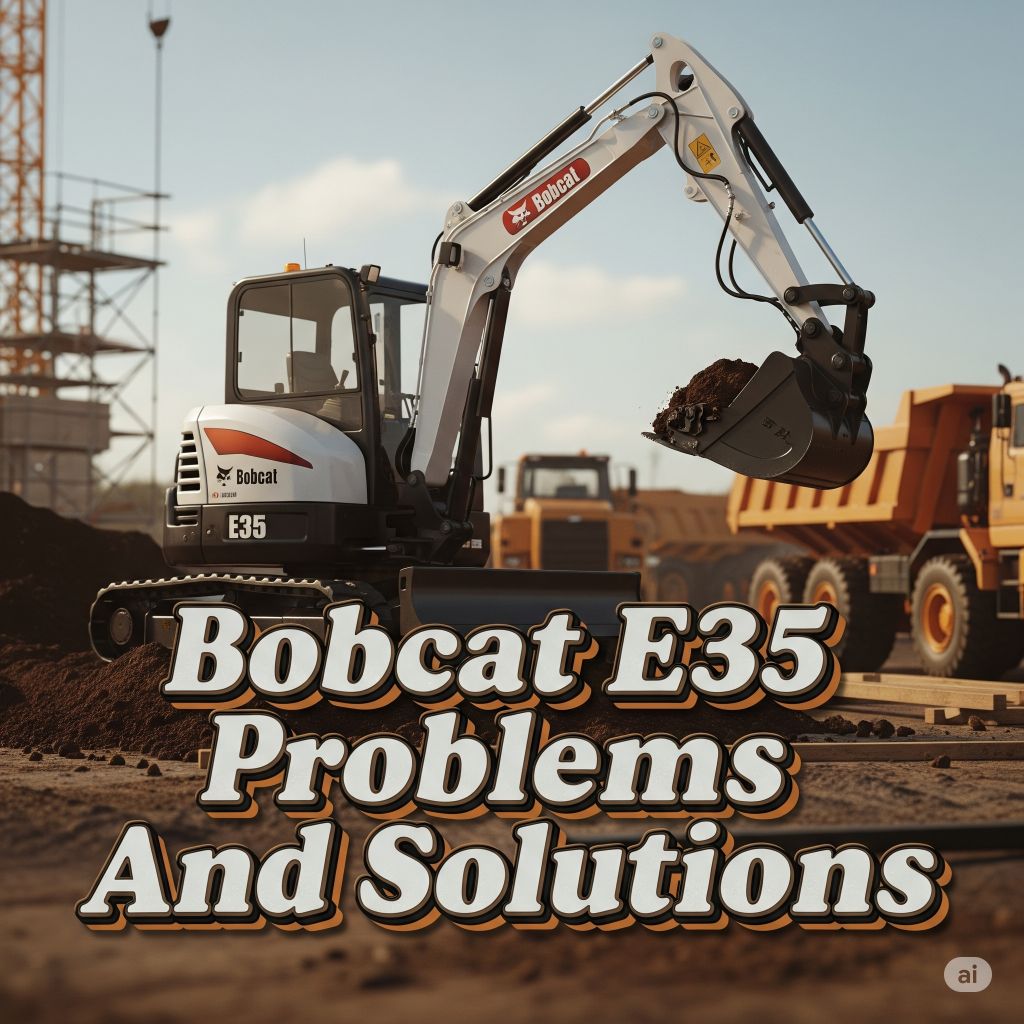
Here’s a comprehensive guide outlining common problems associated with the Bobcat E35 mini excavator and their solutions. The E35 is known for its versatility and performance, but like any piece of machinery, it can face some typical issues.
1. Starting Problems
Symptoms:
- Engine cranks but won’t start.
- No response when the ignition key is turned.
- Engine starts but stalls shortly after.
Common Causes & Solutions:
- Weak Battery:
- Cause: A dead or weak battery can prevent the starter from functioning properly.
- Solution: Check the battery voltage; it should be above 12.4V. Charge or replace the battery if necessary.
- Fuel Issues:
- Cause: Old or contaminated fuel can cause starting issues; clogged fuel filters can restrict fuel flow.
- Solution: Drain the tank and refill with fresh diesel fuel. Replace the fuel filter if clogged.
- Air Filter Blockage:
- Cause: A dirty air filter can restrict airflow to the engine.
- Solution: Inspect and clean or replace the air filter.
- Faulty Starter Motor:
- Cause: A failing starter motor can cause intermittent starting issues.
- Solution: Test the starter motor to see if it’s functioning properly. Replace if faulty.
2. Engine Performance Issues
Symptoms:
- Engine sputters or runs roughly.
- Loss of power under load.
- Engine stalls during operation.
Common Causes & Solutions:
- Dirty Fuel Filter:
- Cause: A clogged fuel filter will restrict fuel flow and affect performance.
- Solution: Replace the fuel filter regularly to ensure smooth operation.
- Clogged Air Filter:
- Cause: A dirty air filter can reduce engine performance.
- Solution: Clean or replace the air filter depending on its condition.
- Fuel Quality:
- Cause: Bad or contaminated fuel can lead to engine misfiring.
- Solution: Use clean, high-quality diesel fuel and consider using fuel additives to clean injectors.
- Injector Problems:
- Cause: Clogged or malfunctioning fuel injectors can disrupt fuel flow.
- Solution: Inspect and clean injectors; replace them if they are beyond cleaning.
3. Hydraulic System Problems
Symptoms:
- Slow or unresponsive hydraulic functions.
- Hydraulic fluid leaks.
- Erratic movement of attachments.
Common Causes & Solutions:
- Low Hydraulic Fluid:
- Cause: Low fluid levels can lead to reduced performance.
- Solution: Check hydraulic fluid levels and top off as necessary with the recommended fluid.
- Clogged Hydraulic Filter:
- Cause: A clogged filter can restrict hydraulic fluid flow.
- Solution: Replace the hydraulic filter according to the maintenance schedule.
- Leaking Hoses:
- Cause: Worn or damaged hoses can cause hydraulic fluid leaks.
- Solution: Inspect hoses regularly for wear or damage and replace them if necessary.
- Faulty Hydraulic Pump:
- Cause: A damaged or failing pump can lead to issues with hydraulic power.
- Solution: If low pressure persists, consult a technician for inspection or replacement of the hydraulic pump.
4. Electrical Issues
Symptoms:
- Dashboard lights not illuminating.
- Accessories (lights, wipers) malfunctioning.
- Ignition problems.
Common Causes & Solutions:
- Blown Fuses:
- Cause: Electrical overloads can cause fuses to blow, disabling functions.
- Solution: Check the fuse box, and replace any blown fuses with the same amperage.
- Corroded Connections:
- Cause: Corrosion can lead to poor electrical connections.
- Solution: Clean connectors and terminals to ensure good connections are made.
- Battery Issues:
- Cause: A dead or weak battery can affect all electrical systems.
- Solution: Test the battery’s voltage and connections. Charge or replace the battery if necessary.
5. Track and Undercarriage Problems
Symptoms:
- Uneven wear on tracks or tires.
- Tracks coming off.
- Difficulty steering.
Common Causes & Solutions:
- Improper Track Tension:
- Cause: Tracks that are too loose or too tight can cause problems.
- Solution: Adjust track tension according to the specifications in the owner’s manual.
- Worn Rollers or Idlers:
- Cause: Aging components can lead to improper track alignment.
- Solution: Inspect and replace worn rollers or idlers.
- Debris Accumulation:
- Cause: Dirt and mud buildup can interfere with the tracks and undercarriage.
- Solution: Regularly clean the undercarriage to remove debris.
Preventive Maintenance Tips
- Regularly Check Fluids: Keep an eye on oil, hydraulic fluid, and coolant levels. Change fluids as per the manufacturer’s recommendations.
- Inspect and Maintain Filters: Clean or replace air and fuel filters periodically to ensure proper airflow and fuel delivery.
- Routine Maintenance: Follow the recommended service schedule in the owner’s manual for replacing belts, spark plugs, and other critical components.
- Keep it Clean: Regularly clean the exterior and undercarriage of the Gator to prevent debris buildup.
Specifications
The Bobcat E35 is a highly versatile compact excavator known for its powerful performance and compact size, making it suitable for various applications, including construction, landscaping, and utility work.
| Specification Category | Feature | Details |
|---|---|---|
| Engine | Type | Diesel, 4-cylinder |
| Model | Bobcat D24 (Doosan) | |
| Displacement | 1.8 Liters (55.8 cc) | |
| Horsepower | 24.8 HP (18.5 kW) | |
| Cooling | Liquid-cooled | |
| Performance | Maximum Operating Weight | 8,200 lbs (3,720 kg) |
| Bucket Force | 3,258 lbs (1,477 kg) | |
| Arm Force | 1,071 lbs (486 kg) | |
| Hydraulic System | Pump Flow Rate | 12.8 GPM (48.5 L/min) |
| Max Operating Pressure | 3,500 PSI (241 bar) | |
| Dimensions | Overall Length | 125.2 in (3,181 mm) |
| Overall Width | 35.2 in (895 mm) | |
| Overall Height | 94.2 in (2,392 mm) | |
| Wheelbase | 57.1 in (1,450 mm) | |
| Ground Clearance | 11.2 in (284 mm) | |
| Digging Depth | 10.6 ft (3,230 mm) | |
| Bucket Capacity | Standard Bucket | 0.15 – 0.19 cubic yards |
| Tires/Wheels | Track Width | 9 in (230 mm) |
| Track Type | Rubber tracks | |
| Weight | Unit Weight | ~7,400 lbs (3,356 kg) |
| Features | ROPS (Rollover Protective Structure) | Yes |
| Control** | Hydraulic thumb option available, AUX hydraulic option available | |
| Warranty | Standard Warranty | 1 year or 1,500 hours; whichever comes first |
Error Codes and Solutions
The Bobcat E35 mini excavator utilizes on-board diagnostics that help users once any issues arise during operation. While it does not have a sophisticated digital error code system, certain indicators light up on the dashboard to alert the operator to specific faults.
Common Warning Indicators & Solutions
| Indicator/Symptom | Meaning/System | Likely Causes | Solution / Action Steps |
|---|---|---|---|
| Oil Pressure Light | Low oil pressure | Low oil level or bad oil pump | Check and refill oil; replace the oil pump if necessary. |
| Temperature Warning Light | Overheating | Low coolant, clogged radiator | Check coolant levels; clean radiator and ensure airflow. |
| Battery/Charging Light | Charging system failure | Weak battery or faulty alternator | Test battery and alternator; replace if necessary. |
| Check Engine Light | General engine fault | Varies: sensor failure, low fuel | Verify fuel levels, check fluids, and inspect relevant sensors. |
| Hydraulic Warning Light | Low hydraulic fluid pressure | Low fluid, filter blockage | Check fluid levels; change filter if necessary. |
| Glow Plug Indicator (Diesel) | Cold start system activated | Glow plugs may be malfunctioning | Test glow plugs; replace as needed. |
| Auto Idle Light | Idle system engaged | Normal operation | No action needed; observe performance during idle. |
Error Code Explanations
While specific “error codes” in the traditional sense are uncommon for the Bobcat E35, knowing some common symptoms and what they indicate can help:
- Oil Pressure Warning: Essential for engine protection; check levels and restore immediately upon warning.
- Temperature Warning: Important for avoiding engine downtime—address cooling system issues promptly to avoid overheating.
- Battery Warning: Signals possible electrical failures requiring immediate attention to avoid being stranded.
- Hydraulic Warning: Reflects low pressure or blockage; when lit, it’s crucial to check fluid levels and surfaces as soon as it’s safe.
Diagnostic Steps
- Initial Checks: Always start with the basics; first, check fluid levels (oil, coolant, hydraulic) and then circuits, followed by filters, connections, and physical components.
- Using Diagnostic Tools: For persistent or unusual issues, a Bobcat technician can use specialized diagnostic software to connect to the machine’s onboard system.
- Service Manual Reference: For interpreting the dashboard lights and descriptions specific to your E35, consult the operator manual.
Conclusion
The Bobcat E35 is a robust and reliable mini-excavator, but like any machinery, common issues can arise. Regular maintenance and prompt attention to symptoms can help you avoid more significant problems down the road. Understanding the potential issues and their solutions will ensure that your Bobcat E35 remains a valuable tool for your operations for years to come. If complex issues persist, consult a certified technician for professional assistance.

I’m David man behind Lawn Mowerly; I’ve been dealing with lawnmowers and Tractors with my father since I was a kid. I know every make and model and what each one is capable of and love helping people find the perfect lawn mower for their needs.
